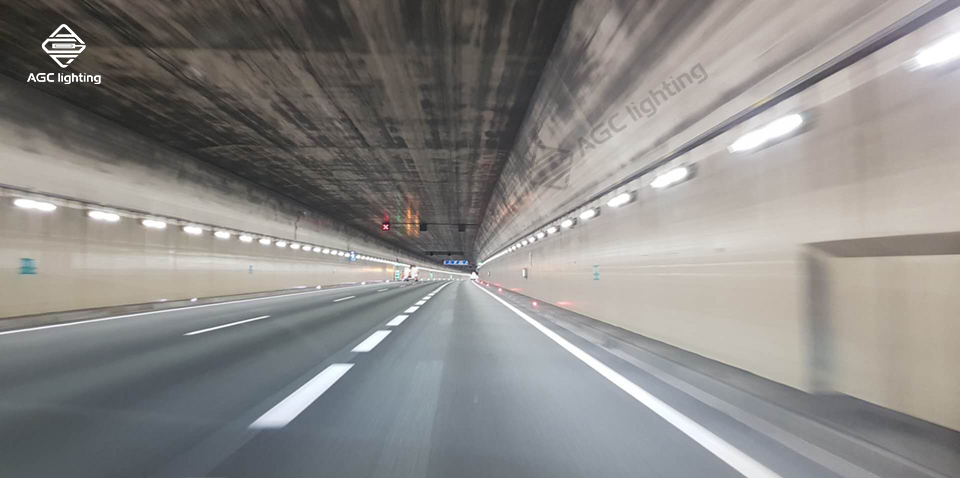Recently AGC found out many clients that have tunnel lighting projects demands. In this blog post, I will explore the key factors to consider when choosing luminaires for tunnel lighting, taking into account various tunnel characteristics. By understanding these factors, you'll be better equipped to make informed decisions.

Tunnel Length and Shape
The length and shape of a tunnel play a significant role in determining the lighting requirements. Longer tunnels may require more luminaires to maintain consistent lighting levels throughout the tunnel. Additionally, the shape of the tunnel, whether it's straight, curved, or has irregular sections, affects the distribution of light. Consider the tunnel's geometry to determine the placement and arrangement of luminaires for optimal illumination.
Traffic Volume and Speed
The amount of traffic passing through the tunnel and the speed at which vehicles are traveling are critical factors to consider. Higher traffic volumes and faster speeds necessitate brighter and more uniform lighting to ensure driver safety and visibility. Select luminaires with appropriate lumen output, beam angles, and uniformity to meet the specific requirements of the tunnel's traffic conditions.
Environmental Conditions
Tunnels are exposed to various environmental conditions, such as humidity, temperature fluctuations, and possible airborne pollutants. It's essential to choose luminaires that are suitable for these conditions to ensure their longevity and performance. Look for luminaires with proper IP (Ingress Protection) ratings, corrosion-resistant materials, and thermal management systems to withstand the tunnel environment effectively.
Energy Efficiency
Energy efficiency is a key consideration in any lighting project. Opt for luminaires that offer high efficacy and utilize energy-saving technologies, such as LED lighting. LED luminaires not only provide significant energy savings but also offer long lifespans, reducing maintenance costs in the long run. Consider energy-efficient lighting control systems, such as dimming or motion sensors, to further optimize energy usage in tunnels.
Safety and Emergency Lighting
Tunnel safety is paramount, and emergency lighting plays a crucial role in ensuring the well-being of occupants during unexpected events, such as power outages or emergencies. When selecting luminaires, check for compliance with safety regulations and standards, including emergency lighting requirements. Consider luminaires with backup power options, such as battery backup systems or automatic switching to emergency lighting mode.
Maintenance and Accessibility
Tunnel lighting systems require regular maintenance to ensure optimal performance. Consider the accessibility of luminaires and ease of maintenance when making your selection. Luminaires that are easy to install, inspect, and replace can significantly reduce maintenance costs and minimize disruptions to traffic flow.
Lighting Uniformity
Achieving uniform lighting distribution is essential to minimize glare, shadows, and dark spots within the tunnel. Consider luminaires with precise optics and beam angles that can provide even illumination across the entire tunnel length. Proper uniformity ensures a consistent visual experience for drivers, enhancing their perception of the road ahead.
Color Rendering
Color rendering is important in tunnel lighting, as it affects the visibility of objects and enhances visual clarity. Choose luminaires with a high color rendering index (CRI) to ensure accurate color perception within the tunnel environment. Adequate color rendering contributes to better recognition of signage, road markings, and potential hazards.
Light Pollution
Tunnel lighting should minimize light pollution, particularly when tunnels are located near residential areas or environmentally sensitive regions. Select luminaires with proper shielding and optics to direct light precisely where it's needed, avoiding unnecessary upward or lateral light spill. This helps preserve the night sky, reduce energy wastage, and mitigate the impact on surrounding ecosystems.
Smart Lighting Solutions
Consider incorporating smart lighting solutions into your tunnel lighting project. Intelligent lighting systems can offer features like adaptive lighting control, where luminaires automatically adjust their output based on traffic conditions and ambient lighting. Smart systems can also enable remote monitoring, maintenance scheduling, and energy optimization, enhancing the efficiency and performance of the tunnel lighting installation.
Compliance with Standards and Regulations
Ensure that the selected luminaires comply with relevant lighting standards and regulations specific to tunnel lighting. These standards often include criteria for illuminance levels, uniformity, emergency lighting, glare control, and energy efficiency. Adhering to these guidelines will help you design lighting systems that meet safety requirements and provide optimal visibility for tunnel users.
Also AGC released series of tunnel lighting, Like TN03 LED tunnel light.

Designing an effective lighting solution for tunnel projects requires careful consideration of various factors. By assessing the tunnel length and shape, traffic volume and speed, environmental conditions, energy efficiency, safety requirements, and maintenance accessibility, you can select the right luminaires for each specific tunnel. Remember, an appropriately designed lighting system enhances safety, visibility, and overall user experience. With this comprehensive guide, you are well-equipped to embark on your tunnel lighting project and make informed decisions that will positively impact the tunnel's functionality and safety.
If you want to know more info about the tunnel lighting, please contact us













